As an Amazon Associate I earn from qualifying purchases.
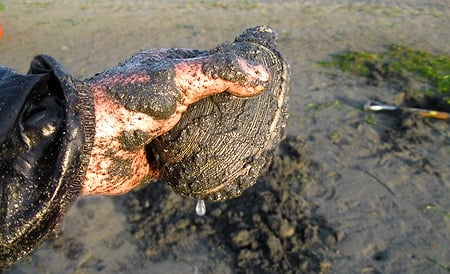
Clamming has always been my first love. With the possible exception of hunting wild onions, clamming has been in my blood longer than any other wild pursuit I do. I can remember my little five-year-old self, chest-deep in the cool waters of Block Island’s Great Salt Pond, digging for quahogs with my feet. I got so good at it I could pick them up with my toes and lift the clams high enough so I could put them in my bucket without ever getting my head wet.
So when I moved within striking distance of the Pacific Coast, I wanted to delve into West Coast clamming in the worst way. But I soon learned that Pacific clamming is, for the most part, very different from what I grew up with. The clams were larger, harder to get, lived in muddier areas — and those areas were few and far between, at least in California.
Looming largest in my mind was Tresus nuttallii, the horseneck clam or gaper. The horseneck clam is to us Californians what the larger geoduck is to Washington state, or what a giant chowder clam is to New England. Living alongside the horseneck is Saxodomus nuttallii, the butter or Washington clam; that’s what I am holding in the picture above. Both make a superior chowder. Sadly, I only know that from restaurants; I’ve struck out every time I’ve searched for them.
Horsenecks and butters are not the tastiest bivalves in the West. I’d say the razor clam, Pismo clam and native littleneck would hold the top spots on the Pacific podium of excellence. But what the larger clams lack in delicacy, they make up for in bulk. A 10-clam limit can net you 2 pounds of pure meat.
There’s something else special about these clams. Keep in mind that foraging is usually defined as hunting for things that don’t run away. So clams are, for the most part, lumped into foraging and not, say, fishing or hunting. But make no mistake: You hunt for horseneck clams. They can escape you as easily as any deer or duck or largemouth bass.
[on_ad]
I learned this Sunday morning — yes, I spent Easter morning on a muddy clam flat. This should not surprise anyone who knows me. We are having some excellent low tides, and my new friend Sol wanted to know if I wanted to head out to Bodega Bay to search for horsenecks and butter clams. Absolutely! This was the chance I’d been waiting for, the opportunity to go clamming with someone with local knowledge.
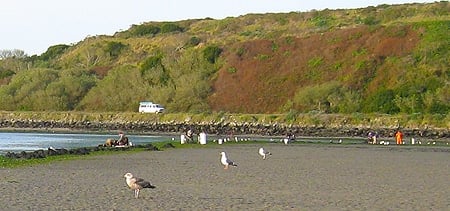
We arrived at the clam flats right at sunrise. To our surprise there were at least 10 other clammers there before us. Guess the lure of low tide bested the call of the church pew. It was already dead low tide, so we had no time to waste. Every minute the tide would roll in further, so we reckoned we’d have two hours to dig, tops.
Remember that while I am an expert clammer in general, I am not an expert clammer in the West. Right off the bat, Sol’s first tip helped me on my way toward gaining that expertise. “Look in the holes,” he said. “Look for what look like lips in the hole.”
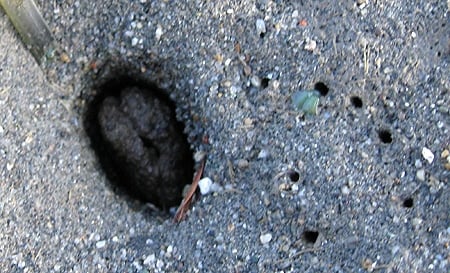
That’s the end of the siphon of either a horseneck or butter clam. Sol’s next pearl of wisdom: That siphon could be more than a foot-and-a-half long. Oh, and the clam on the end of it can bury itself deeper into the ground if it knows you’re coming. So dig fast.
Holy crap! No clam in the East is like this. I’ve never dug more than eight inches into the sand or mud for clams before, even in winter when Eastern quahogs bury themselves deep. OK, then. Here we go.
I soon found an occupied hole. I took a step near it and a geyser of water erupted from its center as the siphon retracted. Game on! I slammed the shovel into the sand beside the hole and dug as fast as I could. Deeper, deeper. No clam. Deeper. No clam. Geez…
“Dig with your hands!” Sol said. “You don’t want to break the shell.” Break the shell? I can’t get near this damn thing, let alone worry about breaking the shell. I clawed at the sand with my hands. Deeper, deeper. Then I felt something. Something firm. Rubbery, and a little leathery. The siphon! I flung myself flat on the sand and grabbed it with my thumb and forefinger. That’s when I realized I was armpit deep in this hole of mine. Or, rather, this hole of the clam’s. My nose was in the sand. I could go no further.
It was a standoff. There was no way I could gain any more leverage on the clam without the hole completely collapsing in on itself. And the clam couldn’t dig itself any deeper because I was holding for dear life onto its siphon. For a long moment we lay there, locked in static combat. Then I did the only thing a higher primate could do, when faced with the stubborn resolve of a mollusk. I let go.
I stood up, panting. God, that was hard! Undaunted, I found another occupied hole. This time I crept softly toward it, shovel at the ready. Deep breath. DIG! I got a full shovel-full away before the clam realized what was happening. I saw the siphon retract, and threw myself after it. Gotchya! This time I had my death grip on the clam’s siphon only about a foot down. I frantically scooped handful after handful of sandy muck with my free hand. I felt the shell. Then the curve around the shell. Leverage! Grunting and gasping, I tugged at the back of the shell, and felt it come free. Success!
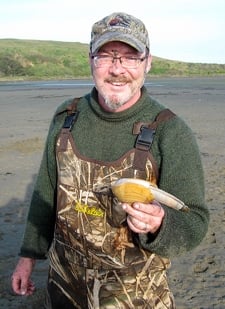
My forearms throbbed uncontrollably. Both arms were on the edge of cramping and several of my fingernails were torn to the quick. Nevertheless, I was as happy as a, well, clam.
Must… get… another.
Sol and I were having a blast. We were on a hot patch, with no shortage of clams to be found. But that doesn’t mean we got ’em all. Not by a long shot. And that’s the coolest part about this sort of clamming: Even though I did get my limit of 10 horseneck clams, along with two butter clams, eight other clams bested me. One was so strong it yanked its siphon free from my grip. Sol and I both think this one might have been a geoduck, the elusive King of All Clams.
In the end, we had our limits by 8:15 a.m. We stood over our buckets, exuberant but exhausted from more than an hour of what Sol calls “full contact clamming.” We filled our buckets with clean seawater and a little eelgrass and headed back to the truck. Conversation shifted to chowders and fritters and fried clam strips.
And to when we can get out again.



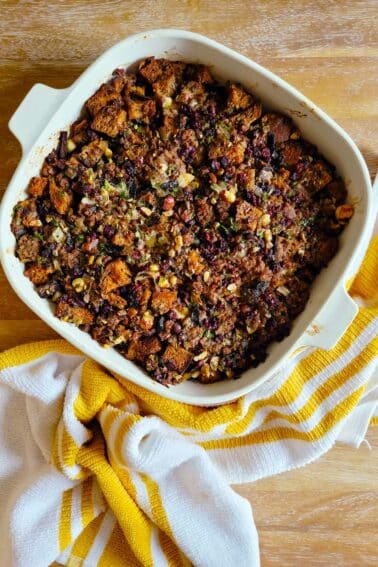
Gapers are one of the few clams I have some experience with up here in Oregon. And cockles, which I do love. Great read as usual.
Bp
Hank, I have to say, although I’m not a hunter, I love learning about all the different methods that you use to hunt, as well as all the different foods there are out there! This is one of my favourite stories yet (only bested mushroom hunting and acorn picking). Thank you so much for the perspective.
Great great article and a very entertaining read. We will actually be clamming in Bodega next Saturday (6:10 low tide). My family and friends have clammed there annually for the past 20 years. We even have a “clammer of the year” trophy awarded to the clammer who digs the biggest clam.
Oh, and we always tell the rookies to dig fast because the clams will run when discovered. Could be true… 🙂
Hank,
Excellent article, I enjoy reading your blog! Doubly so today, as digging for horse clams (what we call them in Washington State) is a family favorite. Almost nobody digs them up here, with butter clams and steamers being much preferred.
Another poster asked about skinning the necks. Here’s what we do –
Once you’ve got the clam out of the shell and the guts removed, I cut the tip of the siphon off, it usually has an orangish/purplish color in the top inch or so. Split the neck length-wise with a sharp knife to aid in washing all the sand off. Then pack the meat skin and all in vacuum sealed bags and freeze it. When you are ready to use for chowder or fritters, the skin comes right off when they thaw.
LOVED this! Since I moved to PDX from Cape Cod, I’ve been dying to get to the beach and go clamming, but have been a bit discouraged. Its a long drive and the licences only allow a scant number of clams… but this really inspired me! time to apply for a licence.
you read some writing, and even before you have finished you know, they have been there, done that! Makes me even more eager for our trip in May…
Ian
PS if you are freezing any, after they thaw the skin on the neck comes off like peeling a banana!
@Hank: Should be fine 🙂 Just give me a few days heads up if you can?
Looking forward to it,
~M
I grew up in a clam-diggin’ town in NJ (Highlands), so I pee salt water when I laugh too hard. I meet so few people who grew up in that sort of environment and it really is an incredible memory. I also love the fact that not only do I know how to clam with my feet, I can gut a fluke, go seining for what usually turns out to be just seahorses and jelly fish (but still!), and I know how to make rainbows in the water at night.
Thanks for posting this and talking about the other coast’s clam situation! Sounds fun!
Editor’s note: This is the fight song of the Evergreen State College Geoducks. Wow. ~Hank
https://www.evergreen.edu/athletics/geoduck.htm
Nice! Glad you were able to get out. Digging horsenecks is just too much fun to miss. Like “protected static” above, I too have heard that horsenecks cannot dig away quickly enough to make a difference, rather they just have incredibly long necks and are burried incredibly deep. That doesn’t mean they don’t regularly escape me simply by virtue of being so damn deep that they are beyond reach.
I’ve been eyeballing the low tides in early May for another outing, you interested?
Kathleen: Name the date and let’s set it up!
Doriantake: I am planning a clamming trip in June. Only problem is that the best tides are midweek, so you’d have to take a day off.
ProtectedStatic: Don’t kill my buzz, dude… 😉
Russell: Nope, no pea crabs this time. But they are edible, you know…
Kurt: They don’t take too long to clean, especially if you are making chowder or fritters. Remove from shell, slit open belly and wash black stuff out under water, remove neck and boil for 10 seconds. The skin slips right off. Had 12 cleaned in 20 minutes.
Oh, and yes, butter and Washington clams are basically the same thing.
Ha ha, I knew you would like going for Gapers!
It makes you feel like a kid again. Looking forward to the recipes!
I’m not sure if he knows this, but I vetted my boyfriend by taking him steamer-ing on Martha’s Vineyard. His style is more hunting than gathering, so needless to say he passed my test. Also – I know from a lifetime of clamming that they can and do run away. Happy hunting!
Hank:
Annually, a large group of us go to Bodega Bay when the tides are low. We call the two types of clams we dig Horsenecks and Washingtons. My guess is
Washington’s are what you call Butter clams.
What you didn’t describe is how hard they both are to clean. We sit for hours cleaning the clams that only took us 45 minutes to dig. Also, do you have any secrets for “skinning” the tube?
Ah but did any of your horses have those horrible little symbiotic Pea Crabs in them? Totally harmless I know, but the first time one suddenly burst claws and legs out of a clam I was cleaning I nearly fainted!
I can’t find the link, but a couple years ago I read an article by a marine biologist who worked for WA DNR that debunked the running away idea. He said that they’re really just buried that deep, and the retraction of their siphon is so fast that it gives the illusion that they’re digging in.
It certainly seems like the damn things are running away, though.
Dammit, Hank. More then once I’ve said that clams are gateway prey because they can’t run away, and now I can’t say it any more.
I will, from now on, appreciate my stationary East Coast clams but, If I ever have the chance, I would love to try for the horsenecks. Great story.
Sounds like a great way to spend easter – we did some hiking and got some gardening done.
If you ever have room for another pair of hands, I’d love to get out there and learn some how-to. I don’t live that far from the Bodega clam beds, but I’ve been hesistant to start digging without someone to point me in the right direction.
We did some clamming around Pismo when I was a kid, but norcal clamming looks like a very different animal,
~M
Fantastic story, Hank. Felt like I was right there alongside you. Let’s go clamming up here in Oregon sometime!
….and this is exactly why I read this blog.
Thanks Hank!